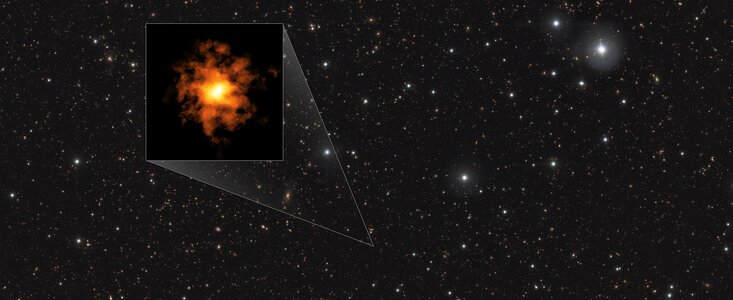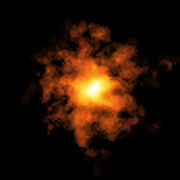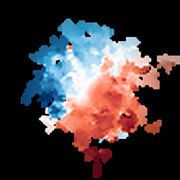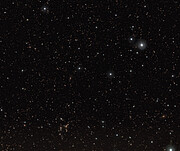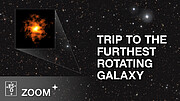Persbericht
Kosmische rariteit: een draaiend schijfstelsel op recordafstand
7 oktober 2024
Onderzoekers hebben het tot nu toe verste Melkweg-achtige sterrenstelsel ontdekt. Dit schijfstelsel, met de aanduiding REBELS-25, ziet er net zo ordelijk uit als de huidige sterrenstelsels, maar we zien het zoals het was toen het heelal pas 700 miljoen jaar oud was. Dat is verrassend omdat, volgens ons huidige begrip van de vorming van sterrenstelsels, zulke vroege sterrenstelsels er naar verwachting chaotischer uit zouden moeten zien. De draaiing en structuur van REBELS-25 is ontdekt met de Atacama Large Millimeter/submillimeter Array (ALMA), waar de Zuidelijke Europese Sterrenwacht (ESO) partner van is.
De sterrenstelsels die we tegenwoordig kennen, hebben een lange ontwikkeling achter de rug ten opzichte van hun chaotische, klonterige tegenhangers zoals astronomen die doorgaans in het vroege heelal waarnemen. ‘Ons begrip van de vorming van sterrenstelsels zegt ons dat de meeste vroege sterrenstelsels er nogal rommelig uitzien’, zegt Jacqueline Hodge, astronoom aan de Universiteit Leiden en medeauteur van het onderzoek.
Deze vroege sterrenstelsels versmelten met elkaar en evolueren vervolgens in een ongelooflijk traag tempo tot gelijkmatigere structuren. De bestaande theorieën wijzen erop dat het miljarden jaren duurt voordat een sterrenstelsel zo ordelijk is als ons eigen Melkwegstelsel – een draaiende schijf met nette spiraalarmen. Maar de ontdekking van REBELS-25 brengt deze tijdschaal aan het wankelen.
Uit het nieuwe onderzoek, dat is geaccepteerd voor publicatie in Monthly Notices of the Royal Astronomical Society, blijkt dat REBELS-25 het verste sterk roterende schijfstelsel is dat ooit is ontdekt. Omdat het licht dat we van dit sterrenstelsel ontvangen werd uitgezonden toen het heelal nog maar 700 miljoen jaar oud was – slechts vijf procent van zijn huidige leeftijd (13,8 miljard jaar) – komt de ordelijke rotatie van REBELS-25 als een verrassing. ‘De ontdekking van een sterrenstelsel dat zo veel overeenkomsten vertoont met onze eigen Melkweg en duidelijk roteert, plaatst vraagtekens bij ons begrip van hoe snel sterrenstelsels in het vroege heelal evolueren tot de geordende sterrenstelsels van nu’, zegt Lucie Rowland, promovendus aan de Universiteit Leiden en hoofdauteur van het onderzoek.
REBELS-25 werd in eerste instantie ontdekt bij eerdere waarnemingen door hetzelfde team, die eveneens werden uitgevoerd met ALMA, die in de Atacama-woestijn in het noorden van Chili is gestationeerd. Het was toen al een spannende ontdekking die tekenen van rotatie vertoonde, maar de gegevens waren niet nauwkeurig genoeg om daar zekerheid over te geven. Om de structuur en beweging van het sterrenstelsel goed te kunnen onderscheiden, deed het team vervolgwaarnemingen met ALMA met een hogere resolutie, en die hebben het recordkarakter van het sterrenstelsel bevestigd. ‘ALMA is de enige telescoop die voldoende gevoeligheid en oplossend vermogen heeft om dit te bereiken’, zegt Renske Smit, onderzoeker aan de Liverpool John Moores Universiteit (VK) en medeauteur van het onderzoek.
Verrassend genoeg bevatten de ALMA-gegevens ook aanwijzingen voor meer ontwikkelde kenmerken zoals onze Melkweg die vertoont, waaronder een centrale langwerpige balk en zelfs spiraalarmen, al zijn er meer waarnemingen nodig om dit te bevestigen. ‘Het zou fascinerend zijn als we bewijs zouden vinden voor nog verder ontwikkelde structuren, omdat dit dan het verste sterrenstelsel tot nu toe zou zijn dat deze vertoont’, aldus Rowland.
De toekomstige waarnemingen van REBELS-25 zullen, samen met andere ontdekkingen van vroege roterende sterrenstelsels, ons begrip van de vroegere vorming van sterrenstelsels en de evolutie van het heelal als geheel op zijn kop zetten.
Meer informatie
De resultaten van dit onderzoek zijn te vinden in het artikel ‘REBELS-25: Discovery of a dynamically cold disc galaxy at z=7.31’, dat in Monthly Notices of the Royal Astronomical Society verschijnt.
De waarnemingen zijn gedaan als onderdeel van het ALMA Large Program REBELS (Reionization Era Bright Emission Lines Survey).
Het onderzoeksteam bestaat uit L.E. Rowland (Sterrewacht Leiden, Universiteit Leiden [Leiden]), J. Hodge (Leiden), R. Bouwens (Leiden), P. M. Piña (Leiden), A. Hygate (Leiden), H. Algera (Astrophysical Science Center, Hiroshima University, Japan [HASC]; National Astronomical Observatory of Japan, Japan), M. Aravena (Núcleo de Astronomía, Facultad de Ingeniería y Ciencias, Universidad Diego Portales, Chili), R. Bowler (Jodrell Bank Centre for Astrophysics, Universiteit van Manchester, VK), E. da Cunha (International Centre for Radio Astronomy Research, University of Western Australia, Australië; ARC Centre of Excellence for All Sky Astrophysics in 3 Dimensions), P. Dayal (Kapteyn Instituut, Rijksuniversiteit Groningen), A. Ferrara (Scuola Normale Superiore, Italië [SNS]), T. Herard-Demanche (Leiden), H. Inami (HASC), I. van Leeuwen (Leiden), I. de Looze (Sterrenkundig Observatorium, Universiteit Gent, België), P. Oesch (Vakgroep Astronomie, Universiteit van Genève, Zwitserland; Cosmic Dawn Center, Denemarken), A. Pallottini (SNS), S. Phillips (Astrophysics Research Institute, Liverpool John Moores Universiteit, VK [LJMU]), M. Rybak (Vakgroep Elektrotechniek, Technische Universiteit Delft; Leiden; Ruimteonderzoeksinstituut SRON), S. Schouws (Leiden), R. Smit (LJMU), L. Sommovigo (Center for Computational Astrophysics, Flatiron Institute, VS), M. Stefanon (Vakgroep Astronomie en Astrofysica, Universiteit van Valencia, Spanje; Vakgroep Extragalactische Astrofysica en Kosmologie, Universiteit van Valencia, Spanje), P. van der Werf (Leiden).
De Atacama Large Millimeter/submillimeter Array (ALMA), een internationale astronomische faciliteit, is een samenwerkingsverband van ESO, de Amerikaanse National Science Foundation (NSF) en de National Institutes of Natural Sciences (NINS) van Japan, in samenwerking met de Republiek Chili. ALMA wordt gefinancierd door ESO (namens haar lidstaten), door de NSF in samenwerking met de National Research Council of Canada (NRC) en de National Science and Technology Council (NSTC) in Taiwan, en door NINS in samenwerking met de Academia Sinica (AS) in Taiwan en het Korea Astronomy and Space Science Institute (KASI). De bouw en het beheer van ALMA worden geleid door ESO (namens haar lidstaten); door het National Radio Astronomy Observatory (NRAO), dat namens Noord-Amerika wordt bestuurd door de Associated Universities, Inc. (AUI), en namens Oost-Azië door het National Astronomical Observatory of Japan (NAOJ). De overkoepelende leiding en het toezicht op bouw, ingebruikname en beheer van ALMA is in handen van het Joint ALMA Observatory (JAO).
De Europese Zuidelijke Sterrenwacht (ESO) stelt wetenschappers van over de hele wereld in staat om de geheimen van het heelal te ontdekken, ten bate van iedereen. Wij ontwerpen, bouwen en exploiteren observatoria van wereldklasse die door astronomen worden gebruikt om spannende vragen te beantwoorden en de fascinatie voor astronomie te verspreiden, en bevorderen internationale samenwerking op het gebied van de astronomie. ESO, in 1962 opgericht als intergouvernementele organisatie, wordt inmiddels gedragen door 16 lidstaten (België, Denemarken, Duitsland, Finland, Frankrijk, Ierland, Italië, Nederland, Oostenrijk, Polen, Portugal, Spanje, Tsjechië, het Verenigd Koninkrijk, Zweden en Zwitserland) en door het gastland Chili, met Australië als strategische partner. Het hoofdkwartier van de ESO en haar bezoekerscentrum en planetarium, de ESO Supernova, zijn gevestigd nabij München in Duitsland, maar onze telescopen staan opgesteld in de Chileense Atacama-woestijn – een prachtige plek met unieke omstandigheden voor het doen van hemelwaarnemingen. ESO exploiteert drie waarnemingslocaties: La Silla, Paranal en Chajnantor. Op Paranal staan ESO’s Very Large Telescope en Very Large Telescope Interferometer, evenals surveytelescopen zoals VISTA. Ook zal ESO op Paranal de Cherenkov Telescope Array South huisvesten en exploiteren – ’s werelds grootste en gevoeligste observatorium van gammastraling. Samen met internationale partners beheert ESO APEX en ALMA op Chajnantor, twee faciliteiten die de hemel waarnemen in het millimeter- en submillimetergebied. Op Cerro Armazones, nabij Paranal, bouwen wij ‘het grootste oog ter wereld’ – ESO’s Extremely Large Telescope. Vanuit onze kantoren in Santiago, Chili, ondersteunen wij onze activiteiten in het gastland en werken wij samen met Chileense partners en de Chileense samenleving.
Links
- Onderzoeksartikel
- Foto's van ALMA
- Voor journalisten: abonneer je op onze persberichten onder embargo in je eigen taal
- Voor wetenschappers: heb je een verhaal? Promoot je onderzoek!
Contact
Lucie Rowland
Leiden Observatory, University of Leiden
Leiden, The Netherlands
Tel: +31 71 527 2727
E-mail: lrowland@strw.leidenuniv.nl
Jacqueline Hodge
Leiden Observatory, University of Leiden
Leiden, The Netherlands
Tel: +31 71 527 8450
E-mail: hodge@strw.leidenuniv.nl
Renske Smit
Astrophysics Research Institute, Liverpool John Moores University
Liverpool, UK
Tel: +44-151-231-2922
E-mail: R.Smit@ljmu.ac.uk
Bárbara Ferreira
ESO Media Manager
Garching bei München, Germany
Tel: +49 89 3200 6670
Mobiel: +49 151 241 664 00
E-mail: press@eso.org
Marieke Baan (Perscontact Nederland)
ESO Science Outreach Network
en NOVA Informatie Centrum
Tel: +31(0)20-5257480
E-mail: eson-netherlands@eso.org
Over dit bericht
| Persberichten nr.: | eso2415nl |
| Naam: | REBELS-25 |
| Type: | Early Universe : Galaxy |
| Facility: | Atacama Large Millimeter/submillimeter Array |
| Science data: | 2024MNRAS.535.2068R |
Our use of Cookies
We use cookies that are essential for accessing our websites and using our services. We also use cookies to analyse, measure and improve our websites’ performance, to enable content sharing via social media and to display media content hosted on third-party platforms.
ESO Cookies Policy
The European Organisation for Astronomical Research in the Southern Hemisphere (ESO) is the pre-eminent intergovernmental science and technology organisation in astronomy. It carries out an ambitious programme focused on the design, construction and operation of powerful ground-based observing facilities for astronomy.
This Cookies Policy is intended to provide clarity by outlining the cookies used on the ESO public websites, their functions, the options you have for controlling them, and the ways you can contact us for additional details.
What are cookies?
Cookies are small pieces of data stored on your device by websites you visit. They serve various purposes, such as remembering login credentials and preferences and enhance your browsing experience.
Categories of cookies we use
Essential cookies (always active): These cookies are strictly necessary for the proper functioning of our website. Without these cookies, the website cannot operate correctly, and certain services, such as logging in or accessing secure areas, may not be available; because they are essential for the website’s operation, they cannot be disabled.
Functional Cookies: These cookies enhance your browsing experience by enabling additional features and personalization, such as remembering your preferences and settings. While not strictly necessary for the website to function, they improve usability and convenience; these cookies are only placed if you provide your consent.
Analytics cookies: These cookies collect information about how visitors interact with our website, such as which pages are visited most often and how users navigate the site. This data helps us improve website performance, optimize content, and enhance the user experience; these cookies are only placed if you provide your consent. We use the following analytics cookies.
Matomo Cookies:
This website uses Matomo (formerly Piwik), an open source software which enables the statistical analysis of website visits. Matomo uses cookies (text files) which are saved on your computer and which allow us to analyze how you use our website. The website user information generated by the cookies will only be saved on the servers of our IT Department. We use this information to analyze www.eso.org visits and to prepare reports on website activities. These data will not be disclosed to third parties.
On behalf of ESO, Matomo will use this information for the purpose of evaluating your use of the website, compiling reports on website activity and providing other services relating to website activity and internet usage.
Matomo cookies settings:
Additional Third-party cookies on ESO websites: some of our pages display content from external providers, e.g. YouTube.
Such third-party services are outside of ESO control and may, at any time, change their terms of service, use of cookies, etc.
YouTube: Some videos on the ESO website are embedded from ESO’s official YouTube channel. We have enabled YouTube’s privacy-enhanced mode, meaning that no cookies are set unless the user actively clicks on the video to play it. Additionally, in this mode, YouTube does not store any personally identifiable cookie data for embedded video playbacks. For more details, please refer to YouTube’s embedding videos information page.
Cookies can also be classified based on the following elements.
Regarding the domain, there are:
- First-party cookies, set by the website you are currently visiting. They are stored by the same domain that you are browsing and are used to enhance your experience on that site;
- Third-party cookies, set by a domain other than the one you are currently visiting.
As for their duration, cookies can be:
- Browser-session cookies, which are deleted when the user closes the browser;
- Stored cookies, which stay on the user's device for a predetermined period of time.
How to manage cookies
Cookie settings: You can modify your cookie choices for the ESO webpages at any time by clicking on the link Cookie settings at the bottom of any page.
In your browser: If you wish to delete cookies or instruct your browser to delete or block cookies by default, please visit the help pages of your browser:
Please be aware that if you delete or decline cookies, certain functionalities of our website may be not be available and your browsing experience may be affected.
You can set most browsers to prevent any cookies being placed on your device, but you may then have to manually adjust some preferences every time you visit a site/page. And some services and functionalities may not work properly at all (e.g. profile logging-in, shop check out).
Updates to the ESO Cookies Policy
The ESO Cookies Policy may be subject to future updates, which will be made available on this page.
Additional information
For any queries related to cookies, please contact: pdprATesoDOTorg.
As ESO public webpages are managed by our Department of Communication, your questions will be dealt with the support of the said Department.
